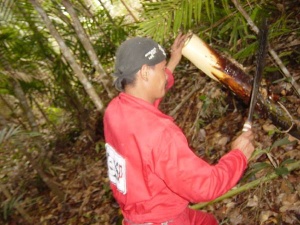Difference between revisions of "Kenangan"
Jump to navigation
Jump to search
(New page: <!---Replace 'Default_Photo.jpg with image filename ---> thumb|300px|'''Ngubud kenangan'''<br>Photo by J.Kokshoorn (Dec 2003) ==Common Name/s== <!---If more tha...) |
|||
| Line 1: | Line 1: | ||
<!---Replace 'Default_Photo.jpg with image filename ---> | <!---Replace 'Default_Photo.jpg with image filename ---> | ||
| − | [[Image:Lraja_ngubud.jpg|thumb|300px|'''Ngubud kenangan'''<br>Photo by J.Kokshoorn (Dec 2003)]] | + | [[Image:Lraja_ngubud.jpg|thumb|300px|'''[[Ngubud]] kenangan'''<br>Photo by J.Kokshoorn (Dec 2003)]] |
==Common Name/s== | ==Common Name/s== | ||
Revision as of 11:07, 3 December 2007
Common Name/s
- Kelabit
- Kenangan (Kanangan)
- Kenangan Buda'
- Kenangan Sia'
- English
- Bornean Sago Palm
- Bahasa Malaysia
- Sagu
Scientific name
- Eugeissonia utilis (1)
Uses
- A most unusual, densely clustering, large palm that grows to about 20 m (67 ft.) tall. Native to the island of Borneo, it forms extensive thickets in tropical rain or heath forest. The suckering trunks are supported by a large number of strong stilt roots. The large crown bears numerous upright to spreading leaves with spiny midribs and elegantly arching leaflets. Each trunk in a cluster flowers only once with a large terminal inflorescence. The fruits are large and covered in small, fringed scales. The seeds are protected by a very hard shell. All parts of the palm are used extensively by local people for construction purposes and thatching. The starchy pith of the trunk is extracted as sago. (2)
- Only very seldom do the Kelabits extract the sago from the palm, they prefer to eat the young palm shoots, eaten as vegetable(1) (ubud kenangan)
- The palm wood (usually of the dead palm) is host to the edible larvae (u'et kenangan)(1), considered a delicacy.
- The leaves may be used as roofing material (apo kenangan), but this is rarely seen nowadays.(1)
- The leaf rachis is used as pith flight on the langan.(1)
- The dead leaves are used as bee repellent on honey collecting trips(1)
- The leaves are medicinal, these are plaited together to form a little container to cook rice. This is good for chilren to eat.(1)
References
- Ethnobotany of the Iban & Kelabit by Hanne Christensen
- www.rarepalmseeds.com
